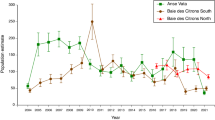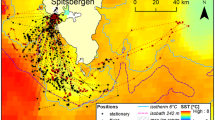Abstract
GUILLEMOTS (Uria aalge) breed on cliff ledges in densely packed colonies often numbering many thousands of pairs. About 25% of the British population of these birds nests in Orkney1, where their proximity to North Sea oil developments makes it important that the numbers breeding are continuously monitored to check for any adverse effects. One of the difficulties in estimating the breeding population is that the numbers present on cliff ledges show considerable variation, particularly before egg-laying2. The data presented here were collected on the island of Copinsay, Orkney, between April 20 and May 13, 1976 with a view to determining the reasons for these fluctuations. They demonstrate the clear effect of a tidal rhythm, a phenomenon previously described for birds which feed close inshore3,4, but not apparently for any species which feeds in deeper water, though Tuck5 makes passing reference to the possibility of such an effect at some of the guillemot colonies which he studied in Canada.
This is a preview of subscription content, access via your institution
Access options
Subscribe to this journal
Receive 51 print issues and online access
$199.00 per year
only $3.90 per issue
Buy this article
- Purchase on Springer Link
- Instant access to full article PDF
Prices may be subject to local taxes which are calculated during checkout
Similar content being viewed by others
References
Lea, D., and Bourne, W. R. P., in The Natural Environment of Orkney (edit. by Goodier, R.), 98–121 (Nature Conservancy Council, Edinburgh, 1975).
Lloyd, C., Brit. Birds. 68, 507–513 (1975).
Boecker, M., Bonner Zool. beitr., 1/2, 15–126 (1967).
O'Connor, R. J., Bird Study, 21, 185–192 (1974).
Tuck, L. M., The Murres (Canadian Wildlife Service, Ottawa, 1960).
Pearson, T. H., J. Anim. Ecol., 37, 521–552 (1968).
Cody, M. L., Ecology, 54, 31–44 (1973).
Reed's Nautical Almanac and Tide Tables, 1976 (Reed, Sunderland, 1975).
Author information
Authors and Affiliations
Rights and permissions
About this article
Cite this article
SLATER, P. Tidal rhythm in a seabird. Nature 264, 636–638 (1976). https://doi.org/10.1038/264636a0
Received:
Accepted:
Issue Date:
DOI: https://doi.org/10.1038/264636a0
This article is cited by
-
Food of young and colony-attendance of adult guillemotsUria aalge on Helgoland
Helgoländer Meeresuntersuchungen (1992)
Comments
By submitting a comment you agree to abide by our Terms and Community Guidelines. If you find something abusive or that does not comply with our terms or guidelines please flag it as inappropriate.



